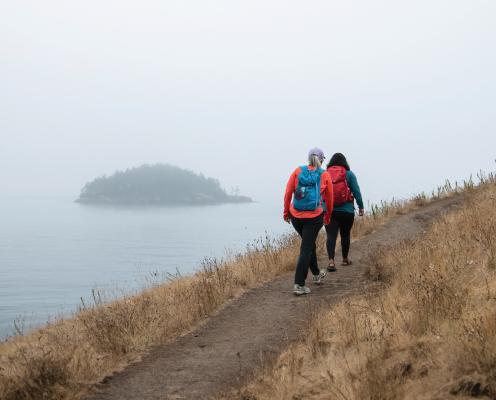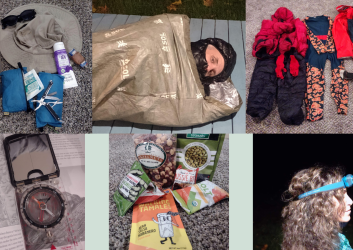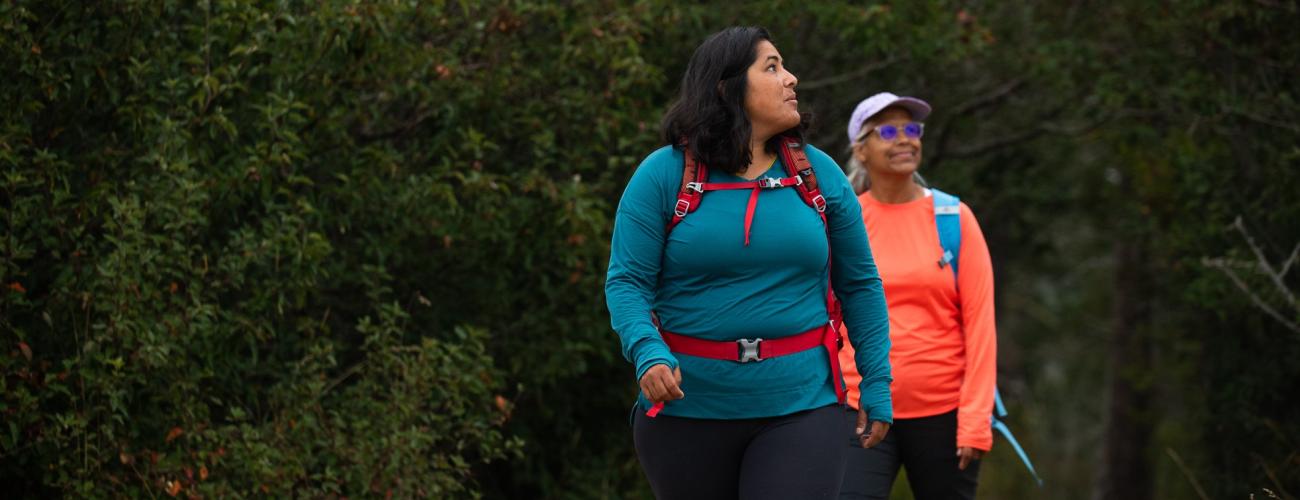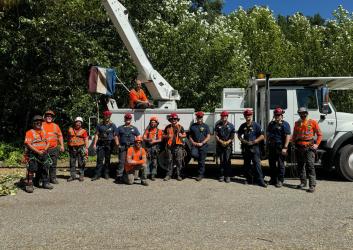The “10 Essentials” to take on every outdoor adventure
Don’t let our parks’ amenities fool you!
Heated restrooms, picnic shelters, attentive staff and hookup campsites aside, you’ll still need a few safety items when you take to our trails!
You may have heard the term “Ten Essentials” or “10Es” in outdoor communities and been left scratching your head. But there’s nothing mysterious about them; they’re basic items to help keep you safe, healthy and comfortable during and after your outdoor adventure.

The 10Es
The Ten Essentials consist of 20+ bits and pieces but grouping them up allows you to organize them in your mind and pack. They are:
1. Sun protection
Includes:
- sunscreen,
- shade hat,
- sunglasses,
- SPF lip balm.
In winter, you may only need a travel-sized tube of sunscreen.
While snowshoeing, you’ll want wrap-around sunglasses with dark lenses. Sunburns from snow, including corneal burns, are the worst! Sun reflects sun off snow, giving you an exponentially increased UV dose – and in surprising places, like the insides of your nostrils!
2. First aid
Most sporting goods and big box stores sell first-aid kits. They include:
- travel-sized, over-the-counter medications,
- bandages,
- antibiotic ointments,
- alcohol wipes.
Add to your kit as needed. Also, extra water will help you clean cuts in the field.
3. Repair kit
You could throw a few things in a baggie and call it good:
- utility knife,
- zip ties,
- duct tape,
- cord,
- fabric tape.
If your shoe’s sole peels away or a rodent gnaws a hole in your tent, a solid repair kit can save your gear – and your vacation!
Pro tip: if you’re flying to your vacation, put the knife in your checked bag.
4. Fire starter
You can carry:
- a flint,
- or a lighter (check fluid levels frequently, store in a dry place)
- or waterproof matches,
- and store-bought or homemade accelerant.
Hand and footwarmers will also keep you warm, but not as warm as an impromptu fire.
5. Shelter
An emergency shelter is the piece of survival gear you hope you’ll never have to use, but if you do, it could save your life.
A shelter can be:
- a couple big garbage bags to stay dry,
- a reflective emergency blanket,
- a bivy sack,
- or a backpacking tent.
6. Nutrition
Don’t skimp on yourself. Bring more calories than you think you’ll need, especially in wintertime!
And bring food you like! When it’s cold and you’re exercising, you’ll ignore the grub you find gross.
7. Hydration
A good rule in Washington’s shoulder season is one liter (32 oz) per person for every four miles hiked or cycled. In summer, you’ll need more.
If you’ll be on a river, stream or lake, you could carry filters, drops or tablets and fill up along the way. (Just be careful at the water’s edge.)
Pro tips:
- Snowshoers, consider bringing insulated bottle holders or a thermos of hot water.
- Electrolyte tabs may motivate you to drink more on cold days, when you can become dehydrated without knowing it.
8. Navigation
These days, most navigation is as easy as putting an app on your phone and knowing how to read it.
If you’re venturing farther out, a map, compass and knowledge of their use can substitute for a failed GPS or dead phone battery.
9. Illumination
Maybe you hiked or rode farther than you intended, or you were having so much fun you lost track of time.
- Your phone’s flashlight might get you back to the car or campsite after dusk, but a headlamp lets you go hands-free in the dark.
- If you’re out in a group after nightfall, everyone should have a headlamp.
10. Extra clothing
Your clothing picks will depend on the season, but this is the Northwest, where weather can change on a dime.
Standard outdoor wardrobes include:
- a rain/wind shell and rain pants,
- warm layer (down or synthetic puffy and pants) and
- wool or synthetic top and bottom base layer.
We recommend bringing an extra pair of wool or synthetic socks. Gloves or mittens and a hat are important accessories.

Nobody starts an outdoor adventure planning to get lost, injured, sunburned, chilled, dehydrated, hungry or huddled under a blanket all night. But if plans go awry, the 10 Essentials will keep you safe (if not comfortable), proud of your new life skills and ready to hit the trail again!
Originally published November 28, 2023





